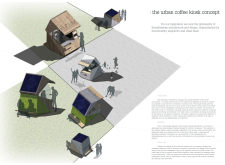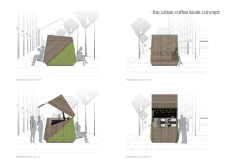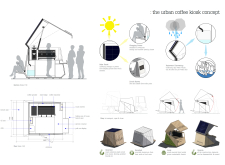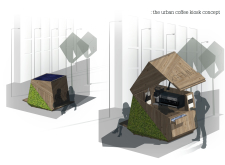5 key facts about this project
The kiosk is strategically designed with attention to both aesthetics and functionality. It utilizes recycled materials such as aluminium and wood while incorporating living green facades that enhance biodiversity within urban landscapes. This integration of natural elements not only improves the visual character of the structure but also contributes to environmental sustainability.
Unique Design Approaches
The project stands out due to its multifunctionality and adaptability. It serves as a meeting point that encourages interaction among community members, rather than merely acting as a point of sale. Features such as seating integrated into the design further invite users to linger and connect with each other.
A distinctive aspect of the Urban Coffee Kiosk is its mobility. The kiosk can be relocated, offering versatility in its placement throughout the urban space. This allows it to participate in various community events, enhancing engagement across different demographics. Furthermore, the inclusion of charging points and digital interfaces streamlines user experience and reflects modern consumer habits.
Environmental considerations are paramount in the design. The incorporation of solar panels and a water harvesting system demonstrates a commitment to energy efficiency and sustainability. By employing these technologies, the kiosk minimizes its ecological footprint and serves as a model for future developments in urban architecture.
Sustainable Practices and Materiality
The choice of materials highlights a focus on sustainability. Recycled aluminium cladding and upcycled wood from deconstructed structures reflect a thoughtful approach to resource use. The living wall systems not only serve an aesthetic purpose but also provide insulation and improve air quality, showcasing the potential of biophilic design in urban settings.
In summary, the Urban Coffee Kiosk is a well-conceived architectural design that addresses both functional and communal needs in a contemporary urban context. Its thoughtful integration of sustainability, mobility, and user-centered features distinguishes it from traditional commercial structures. This project serves as a compelling example of how modern architecture can effectively align with principles of community engagement and environmental stewardship.
For more detailed information, including architectural plans, sections, and design ideas, readers are encouraged to explore the project presentation. An in-depth review of these elements can provide greater insight into the key architectural decisions that shaped this innovative design.


























